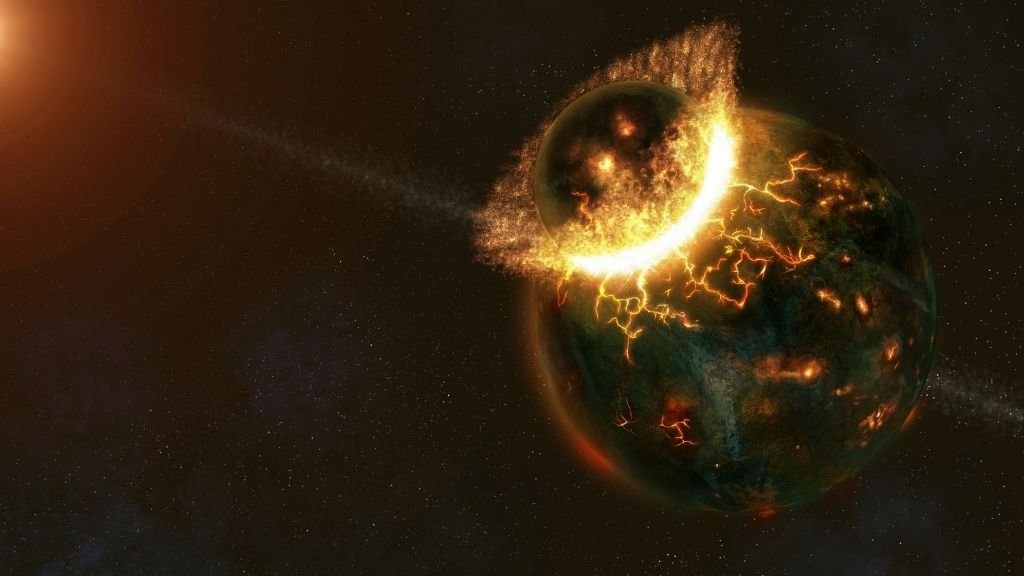Fragments of the hellish, lava-covered “proto-planet” that existed before Earth 4.5 billion years ago have survived unaltered in ancient rocks, groundbreaking new research reveals.
The fragments contain telltale potassium signatures not seen in any other rocks or meteorites that scientists have examined so far, according to a study published Oct. 14 in the journal Nature Geoscience. Theoretically, these signatures should have disappeared in the giant collision that formed the moon, but it now appears that a handful survived this cataclysmic event and subsequently withstood the test of time.
Proto-Earth was a sizzling ball of bubbling, molten rock that formed from cosmic dust and meteorites in the early solar system. But after 100 million years, our early planet was rocked by a catastrophic impact with a Mars-size planet called Theia. The collision was so powerful that it completely scrambled proto-Earth’s interior and blasted off a chunk of Earth’s precursor that became the moon.
Theia also delivered vast amounts of new material to proto-Earth, irreversibly altering the chemistry of Earth’s precursor and transforming it into a planet more like today’s. Over the eons, plate tectonics emerged, and material was repeatedly recycled into Earth’s interior. As a result, scientists didn’t think it was possible to find intact fragments of proto-Earth in modern rocks.
Researchers have previously found rocks with unusual chemical signatures linked to the element ruthenium that possibly predate the moon-forming impact, but these signatures could equally have originated after the collision, so they don’t provide robust evidence, Philip Carter, a computational planetary scientist and astrophysicist at the University of Bristol in the U.K., told Live Science.
The newly discovered potassium signatures, on the other hand, are the most definitive evidence to date that bits of proto-Earth still exist, Carter, who was not involved in the study, added. “The most reasonable explanation is that this is material that has survived from before the impact,” he said.
Clues in potassium ratios
The newfound signatures are subtle imbalances in the proportion of different versions, or isotopes, of the element potassium compared with other materials on Earth. Potassium has three naturally occurring isotopes — potassium-39, potassium-40 and potassium-41 — that have the same number of protons but different numbers of neutrons, which gives them different atomic masses.
Potassium-39 and potassium-41 dominate in Earth’s rocks, with potassium-40 existing only in trace amounts. In previous work, the new study’s authors found abnormal quantities of potassium-40 in meteorites, which record changing conditions in the solar system over long periods of time. This suggested that potassium isotopic anomalies can mark out material that predates the formation of modern Earth.
For the new study, Nie and her colleagues sampled ancient rocks from a handful of locations that previously yielded weird ruthenium signatures, including outcrops in Greenland, Canada and Hawaii. To pick out any potential potassium isotopic anomalies, the researchers powdered the rocks and dissolved them in acid. They then isolated the potassium in the samples and measured the ratio of different potassium isotopes using a mass spectrometer.
The rocks were deficient in potassium-40 compared with the amounts in other materials on Earth, the researchers found. To work out whether this potassium isotopic anomaly could date back to proto-Earth, the team carried out computer simulations. Using data from every known meteorite that has landed on Earth, they modeled the effects of these impacts and the moon-forming impact on Earth’s composition through the delivery of new material over the eons.
The simulations revealed that the collision with Theia, in particular, dumped lots of potassium-40 onto Earth, explaining the higher amount of potassium-40 we see in rocks today. “You have to add a significant amount of material to … change the overall signature and the overall isotopic composition of potassium in most rocks,” Carter said. “Most of that change comes from the moon-forming impact itself — that’s the argument that they use in the paper.”

The potassium signature discovered in the ancient rocks is different to that which Nie and her colleagues previously found in meteorites, so it’s unlikely that meteorites could have created Earth’s current potassium profile after the moon-forming impact. “It’s really saying that the proto-Earth formed from material that is isotopically distinct from any of the meteorites we have,” Carter said.
The moon-forming impact is the only known event that could have significantly increased the amount of potassium-40 in rocks on Earth, Carter said. This means that the potassium-40-deficient rocks from Greenland, Canada and Hawaii are older than the moon-forming impact and date back to proto-Earth, he said.
Martin Schiller, an associate professor of geochemistry at the University of Copenhagen in Denmark who was not involved in the study, agreed that the results are convincing. “The really surprising/novel observation is that the potassium isotope signature [in the ancient rocks] cannot be explained with a mixture of primitive meteorites,” he told Live Science in an email.
The results imply that remnants of proto-Earth survived geological processes like the constant mixing of the mantle, the layer of Earth that sits beneath the crust.
“It’s a signature that’s been preserved separate from the rest of Earth’s rocks for some significant portion of time,” Carter said. And there is likely more of this proto-Earth material hiding at the base of the mantle, he said. “We’re only getting the little bits that come up.”


